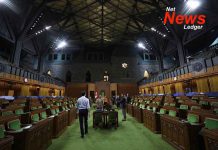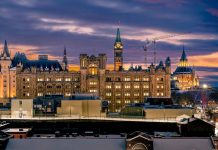Thunder Bay – POLITICAL Opinion – The Canadian political landscape has been marked by several contentious episodes, but few have had as lasting an impact on Alberta as the National Energy Program (NEP) initiated in the 1980s under Prime Minister Pierre Trudeau and then Energy Minister Marc LaLonde.
This federal initiative, aimed at increasing Canadian ownership in the Oil and Gas Sector, led to significant economic and political repercussions in Alberta, reshaping the province’s relationship with the federal government for decades.
The National Energy Program was embraced by Dome Petroleum. The company created a Canadian subsidiary Dome Canada in order to gain access to the federal grants. It was the only company in the Oil Patch to take the policies of the NEP and take advantage of them.
Dome Petroleum also became one of the largest financial failures when it almost defaulted on almost $5 billion in loans from all the major Canadian and many US banks.
Petro Canada was one of the creations coming out of the NEP. However most of the oilpatch in Alberta simply saw the federal program as “NEPOTISM”.
Today growing numbers of Albertans are seeing Prime Minister Justin Trudeau’s Carbon Tax as the modern day NEP.
Alberta has made, in recent years a lot of effort to diversify its economy. Moves into Hydrogen and wind energy are two areas.
Is Justin Trudeau Following His Father’s Political Playbook?
Today, Prime Minister Justin Trudeau is starting to be seen, by some, as taking a page out of his father’s political playbook. The move this time is still against Alberta, but instead of increasing Canadian ownership, the Liberal Prime Minister’s stated goal is meeting Canada’s climate change goals.
This move is causing a political backlash in Alberta.
When the National Energy Program was imposed, the unemployment rate in Alberta rose from 3.7 percent to 12.4 percent, the bankruptcy rate in Alberta rose by 150 percent, and Alberta’s losses were estimated to be between $50 billion and $100 billion.
Alberta is not the same province it was back in the 1980s, but Albertans remember the economic and social impact of the NEP. Today many are feeling that way about the moves, often unilateral that they see impacting their futures.
The overall impact politically and economically of the Carbon Tax and other measures is likely to be similar today to what happened in the 1980s.
Prime Minister Pierre Trudeau left federal politics before the Liberals under John Turner were reduced to 40 seats in the House of Commons. Today Justin Trudeau is at the political low end of popularity with polls suggesting 74% of Canadians would like him to resign. The federal Conservatives are at a whopping 40% in the polls compared to the Liberals at 22%.
The question arises, is Justin Trudeau working to rebuild his political popularity by using the wedge issue of his carbon tax against Alberta and the federal Conservatives led by Pierre Poilievre?
Alberta as far as the Liberal Party is concerned is a political desert. The Provincial Liberal Party has no seats in the legislature and in the 2023 general election, the Alberta Liberals got its lowest vote record in its history with just 0.24%. There are only two Liberals serving federally in Alberta, one from Calgary and one from Edmonton.
So looking at history, as said, ‘If you don’t study history, you are doomed to repeat it”.

Introduction: The National Energy Program and its Legacy
The NEP, introduced in 1980, sought to redistribute wealth from the oil-rich provinces to the federal government, with an emphasis on Canadian ownership and control in the oil and gas sector. This program, however, was perceived in Alberta as an economic attack, creating deep-seated tensions that have persisted over the years.
Economic Impact of the NEP on Alberta in the 1980s
For Alberta, rich in oil and gas resources, the NEP was nothing short of an economic calamity. The program led to a drastic reduction in investment in the province’s energy sector, causing a virtual shutdown of its economy. This period is remembered as one of significant hardship in Alberta, fueling resentment towards the federal government.
Political Unrest and the Rise of the Reform Party The economic distress and perceived federal overreach under the NEP catalyzed political unrest in Alberta. This environment contributed to the formation of the Reform Party of Canada, a political movement born out of Western Canadian discontent. The party aimed to address the concerns of Albertans who felt marginalized by the federal policies of the time.
The Trudeau-Alberta Tension: A Historical Perspective The NEP era entrenched a perception among many Albertans of the federal Liberals as imposing “Eastern views” on their province. For years, this sentiment eroded the Liberal Party’s political prospects in Alberta, with the party struggling to gain significant support in the region.
Comparing Past and Present: Justin Trudeau’s Approach to Alberta Today, questions arise about whether Prime Minister Justin Trudeau is following in his father’s footsteps in his dealings with Alberta, particularly under the leadership of Premier Smith. While there are parallels in the federal government’s involvement in energy policies, the context and challenges of the present day differ significantly from those of the 1980s.
The Future of Federal-Alberta Relations As Canada continues to navigate complex energy and environmental issues, the relationship between the federal government and Alberta remains a topic of keen interest and importance. How Justin Trudeau’s administration engages with Alberta and addresses the legacy of the NEP will be crucial in shaping the future of this longstanding and dynamic relationship.
The Goal
The goal should be bringing all Canadians along in moving toward a carbon neutral future. While there are those who are putting emotion over logic and denying the overall long-term impact of climate change, the science is there, and the efforts we need to do together are apparent.
It is the real job of the government leaders to continue to educate, illuminate and be open and transparent about the entire process we are all working on to reduce our impact on the earth.
We all live on this planet and there isn’t a Planet B.
James Murray







